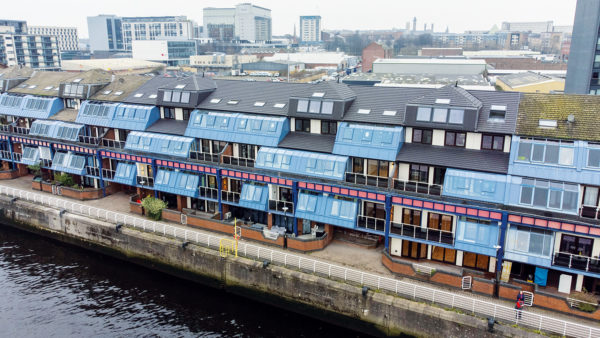
Kingspan staff sent each other messages internally joking that claims about the fire performance of its insulation products were “lies” and that the K15 product, a quantity of which was used on Grenfell Tower, was a “shit product”.
The Grenfell Tower Inquiry heard details of an instant messenger chat between two of Kingspan’s technical team, Peter Moss and Arron Chalmers, that linked to an email sent by Moss on 9 November 2016.
The pair discussed a question about which Kingspan insulation products were class 0 (a surface of no flame spread).
Moss said: “Yeah, he wanted to use K7 and I said only K10/K110/K15 are comparable whereas K7 has a class 1 surface spread of flame but not a ‘class 0’ product.”
Chalmers replied: “Doesn’t get class 0 when we test the whole product though. LOL!”
Moss replied: “WHAT. We lied? Honest opinion now.”
Chalmers replied: “Yeahhhh. Tested K15 as a whole – got class 1. Wheyy. Lol.”
Moss replied: “Shit product. Scrap it.”
Chalmers said: “But England/Wales is worded in such a way that it ‘implies’ the facing can give you class 0. Scotland is written better, therefore our product is not class 0 in Scotland haha. But don’t tell anyone that.”
Moss then quoted Kingspan marketing literature: “Kingspan Kooltherm K15 is class 0 (non combustible).”
Chalmers replied: "All lies mate…Alls we do is lie in here.”
Adrian Pargeter, who was Kingspan’s head of marketing and technical at the time, told the Inquiry: “I mean, reading that, it’s certainly not the view that they espouse externally, and it’s very disappointing to read that from my perspective.”
Asked by lead counsel to the Inquiry Richard Millett QC if “all we do is lie in here” was an accurate summary of Kingspan’s culture at the time, Pargeter said: “I don’t believe that’s true at all.”
Internal discussions over how to market K15
Pargeter was also grilled about a long 2016 email chain in which he and colleagues in the marketing and technical departments discussed whether or not K15 could be marketed as class 0. The discussion arose after it emerged that in some cases, K15’s core only achieved class 2. Pargeter’s colleague Reshma Roodurmun discussed the need to remove references to K15 achieving class 0.
In a June 2016 email, Pargeter told colleagues: “The decision was made today to remove the reference to class 0 because I was advised that neither the core or the film [foil facer] will conform to Class 0. It will potentially be damaging to remove it but not prepared to say we pass if we don’t.”
He then asked his technical team “So which is it? Does the facer pass or not?”
His colleague Dan Ball appeared to suggest that Kingspan could choose to decide to claim class 0 for the K15 product, based on a class 0 test on the facer alone, and then not reveal that the test was on the facer only.
As a result, Reshma Roodurmun came up with two different forms of words for marketing K15. If the foil face met class 0 on its own, she proposed writing: “Kingspan Kooltherm K15 Rainscreen Board is Class 0 as defined by the Building Regulations.” However, if in the future, the core achieved class 0 too, she proposed reverting to the statement: “Kingspan Kooltherm K15 Rainscreen Board and it’s [sic] rigid phenolic insulation core is Class 0/Low Risk as 7 defined by the Building Regulations/[Standards].”
Millett asked Pargeter: “What did you make of that message as head of technical and marketing?”
Pargeter said: “I thought it was an accurate way to describe the performance of the product, the difference between the building regs and the Scottish standards.”
Millett asked: “It didn’t occur to you that that was an utterly disingenuous and opportunistic interpretation?”
Pargeter denied that it was.
Millett asked: “Didn’t you think at the time that testing the facer alone and then claiming class 0 for Kingspan K15 as a product was misleading?”
Pargeter said: “No, I didn’t…Because it was an interpretation of ADB [Approved Document B].”
Millett went on: “How would any buyer of K15 know that you had adopted that interpretation and tested to class 0 only the foil facer and not the entire product?”
Pargeter replied: “Only by defining it as defined by the Building Regulations, that…”
Millett said: “You think that was it, was it, those words, ‘as defined by the Building Regulations’?”
Pargeter replied: “That would be it, yes.”
Millett asked: “Did you really honestly think at the time that by using those words, you were signalling in clear terms to a buyer of K15 that you had only tested the foil facer and not the entire composite product?”
Pargeter replied: “No, I don’t think I would have…But they’d know that a product was class 0 by the definition of the Building Regulations.”
Summing up the exchange, Millett said: “What I would suggest to you that these emails show thus far is the evolution over some two days in June 2016 of a plan to sell K15 on the basis of a claim that it was a class 0 product knowing that only the surface could be described as such, and then to justify that statement by reference to a novel and unverified meaning of ADB that you had not verified outside the business. Do you accept that as a fair summary of what was going on here?”
Pargeter replied: “I don’t think it was a novel interpretation. The business had used that interpretation for quite some time, so it wasn’t novel to Kingspan. Whether it was novel in terms of competition, I wouldn’t know.”
Millett said: “Well, you see, this is about life safety, isn’t it? Class 0 is about saving lives, ultimately, isn’t it?”
Pargeter said: “Well, it’s about small-scale fire performance.”
Millett replied: “Yes, but the point of doing the tests is to make sure that there aren’t fires in which people are either injured or die or lose their property.”
Pargeter replied: “Potentially, yes.”
The Inquiry continues.
Comments
Comments are closed.










Whilst these revelations about the behind-the-scenes goings-on in the insulation manufacturers’ offices may seem alarming, it would be naïve to think that such conversations and misrepresentations, albeit perhaps more elegantly phrased, do not occur privately in the board rooms, partnership meetings or “compliance” departments in other industries or professions. For example: How can we deceive the utility regulator? How can we circumvent the Bank of England’s rules? How can we convince a jury that our client is innocent? How can we distort the emissions figures? “Getting away with it” often appears to be regarded as a commendable achievement to some people, regardless of the costs to others.
And selective presentation of facts accompanied by pseudo-science and mumbo-jumbo is the norm in much advertising.
It would be unfair to single out one for censure while giving plaudits, profits, subsidies and bail-outs to others.
Charles Worby, 13 December 2020